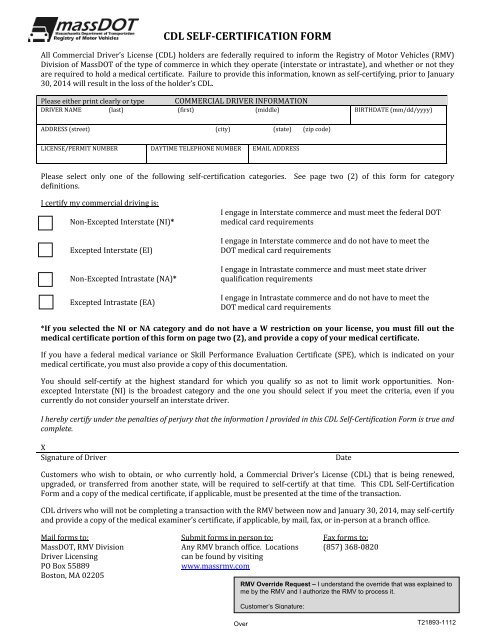All Commercial Driver License (CDL) holders licensed in Georgia, may submit their Medical Certifications online. However, CDL drivers wishing to certify their driving category or make a change to their CDL Self Certification Status must submit the CDL Self Certification Form in person at a DDS Customer Service Center. Jan 10, 2017 For example, Microsoft no longer provides tools to develop or WHQL certify Windows XP drivers. Windows For Windows, Silicon Labs will actively support a version of Windows (i.e. XP, 7, 10) until the end of Microsoft's mainstream support window. Driver Signing.; 2 minutes to read; t; D; C; In this article. Driver signing associates a digital signature with a driver package. Windows device installation uses digital signatures to verify the integrity of driver packages and to verify the identity of the vendor (software publisher) who provides the driver packages.
Note

Starting with Windows 10, version 1607, Windows will not load any new kernel-mode drivers which are not signed by the Dev Portal. To get your driver signed, first Register for the Windows Hardware Dev Center program. Note that an EV code signing certificate is required to establish a dashboard account.
There are many different ways to submit drivers to the portal. For production drivers, you should submit HLK/HCK test logs, as described below. For testing on Windows 10 client only systems, you can submit your drivers for attestation signing, which does not require HLK testing. Or, you can submit your driver for Test signing as described on the Create a new hardware submission page.
Exceptions
Cross-signed drivers are still permitted if any of the following are true:
- The PC was upgraded from an earlier release of Windows to Windows 10, version 1607.
- Secure Boot is off in the BIOS.
- Drivers was signed with an end-entity certificate issued prior to July 29th 2015 that chains to a supported cross-signed CA.
To prevent systems from failing to boot properly, boot drivers will not be blocked, but they will be removed by the Program Compatibility Assistant.
Signing a driver for client versions of Windows
To sign a driver for Windows 10, follow these steps:
- For each version of Windows 10 that you want to certify on, download the Windows HLK (Hardware Lab Kit) for that version and run a full cert pass against the client for that version. You'll get one log per version.
- If you have multiple logs, merge them into a single log using the most recent HLK.
- Submit your driver and the merged HLK test results to the Windows Hardware Developer Center Dashboard portal.

Drivers Certificate Of Completion
For version-specific details, please review the WHCP (Windows Hardware Compatibility Program) policy for the Windows versions you want to target.
To sign a driver for Windows 7, Windows 8, or Windows 8.1, use the appropriate HCK (Hardware Certification Kit). For more information, see the Windows Hardware Certification Kit User's Guide.
Signing a driver for earlier versions of Windows
Before Windows 10, version 1607, the following types of drivers require an Authenticode certificate used together with Microsoft's cross-certificate for cross-signing:
- Kernel-mode device drivers
- User-mode device drivers
- Drivers that stream protected content. This includes audio drivers that use Protected User Mode Audio (PUMA) and Protected Audio Path (PAP), and video device drivers that handle protected video path-output protection management (PVP-OPM) commands. For more information, see Code-signing for Protected Media Components.
Signing requirements by version
The following table shows signing policies for client operating system versions.


Driver's Certification Of Violations

Note that Secure Boot does not apply to Windows Vista and Windows 7.
| Applies to: | Windows Vista, Windows 7; Windows 8+ with Secure Boot off | Windows 8, Windows 8.1, Windows 10, versions 1507, 1511 with Secure Boot on | Windows 10, versions 1607, 1703, 1709 with Secure Boot on | Windows 10, version 1803+ with Secure Boot on |
|---|---|---|---|---|
| Architectures: | 64-bit only, no signature required for 32-bit | 64-bit, 32-bit | 64-bit, 32-bit | 64-bit, 32-bit |
| Signature required: | Embedded or catalog file | Embedded or catalog file | Embedded or catalog file | Embedded or catalog file |
| Signature algorithm: | SHA2 | SHA2 | SHA2 | SHA2 |
| Certificate: | Standard roots trusted by Code Integrity | Standard roots trusted by Code Integrity | Microsoft Root Authority 2010, Microsoft Root Certificate Authority, Microsoft Root Authority | Microsoft Root Authority 2010, Microsoft Root Certificate Authority, Microsoft Root Authority |
In addition to driver code signing, you also need to meet the PnP device installation signing requirements for installing a driver. For more info, see Plug and Play (PnP) device installation signing requirements.
For info about signing an ELAM driver, see Early launch antimalware.
Signing a driver for internal distribution only
In some cases, you may want to distribute a driver internally within a company rather than via Windows Update. To do this without requiring that computers running it are in test mode, use the following procedure:
- Register for the Hardware Dev Center.
- Review the Hardware dashboard FAQ and sign appropriate agreements.
- Upload codesign certificates.
- Sign drivers locally using any codesign certificate that you have already registered in Partner Center.
- Package drivers in a CAB and sign the CAB using the above codesign certificate.
- Submit the CAB to the Hardware Dev Center for signing.
- If the submission is approved, the Hardware Dev Center returns the driver with a Microsoft signature.
- Distribute the driver internally.
See Also
